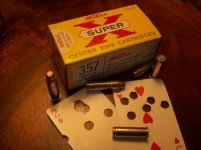I brought my two sons shooting today and they did great. They each filled playing cards with six holes at ten yards, and also made soda cans dance around. They loved the Combat Magnum. We had a blast...that's what it's all about. The ammo was my handloaded .38 special dewc in front of 3.4 grs of tightgroup. Then, after 50 shots of this, we fired 18 shots of .357 magnum. They were Western Super X 158 gr lubaloy. The box also said nickel plated case, inside lubricated. The bullets have a copper color to them but do look jacketed. This box of shells was from 1968.
I got home and sat down to clean it and that is when I saw lead sprayed around the rim of the muzzle and the bore hopelessly fouled.
The reloads have never fouled my bore before, so I suspect it was the .357 factory loads.
2 questions...
1. Are these old factory rounds known to cause this?
2. What is a good way to clean the bore without harming the gun?
Thanks,
bigmoose
I got home and sat down to clean it and that is when I saw lead sprayed around the rim of the muzzle and the bore hopelessly fouled.
The reloads have never fouled my bore before, so I suspect it was the .357 factory loads.
2 questions...
1. Are these old factory rounds known to cause this?
2. What is a good way to clean the bore without harming the gun?
Thanks,
bigmoose

